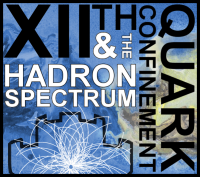Speaker
Description
Bernhard Ketzer [Bernhard.Ketzer@cern.ch]
Summary
We show that a single $I=1$ spin-parity $J^{PC}= 1^{++}$ $a_1$
resonance can manifest itself as two separated mass peaks, one decaying into an S-wave $\rho\pi$ system and the second
decaying into a P-wave $f_0(980)\pi$ system, with a rapid increase of the phase difference between their amplitudes arising mainly
from the structure of the diffractive production process. This study clarifies questions related to the mass, width, and decay rates of the
$a_1$ resonance raised by the recent high statistics data of the COMPASS collaboration on $a_1$ production in
$\pi N \rightarrow \pi \pi \pi N$ at high energies. This presentation will be based on Phys Rev Letters 114, 192001 (2015) with Jean-Louis Basdevant and more recent research.
